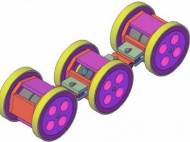Robotic ferret will reduce human trafficking?
 The 3-year project ‘Cargo Screening Ferret’ began in October 2008 and it involves researchers from the University of Glasgow, Loughborough University, City University London and defense and security specialists Qinetiq. The ferret will offer major advantages in combat against human trafficking. Currently, it is very difficult to detect people hidden in freight containers. Sensors on the ferret will be able to detect tiny traces of carbon dioxide which indicate the presence of humans concealed in the containers. It will also make tasks as detection of drugs, weapons, explosives much easier.
The 3-year project ‘Cargo Screening Ferret’ began in October 2008 and it involves researchers from the University of Glasgow, Loughborough University, City University London and defense and security specialists Qinetiq. The ferret will offer major advantages in combat against human trafficking. Currently, it is very difficult to detect people hidden in freight containers. Sensors on the ferret will be able to detect tiny traces of carbon dioxide which indicate the presence of humans concealed in the containers. It will also make tasks as detection of drugs, weapons, explosives much easier.
Another key benefit is that the ferret will reduce the need for customs and security officials to enter or unpack freight containers, which is time-consuming and may expose officers to danger or possible contamination by harmful substances. By combining two different types of sensor (laser and fiber optic-based), the ferret will lead to confidence in detection being considerably improved.
Recent advances in both laser and fiber optic technology now make it possible to detect tiny particles of different substances. The EPSRC-funded project team is developing sensors which incorporate these technologies and that are small enough to be carried on the 30cm-long robot, in order to detect the specific ‘fingerprint’ of illegal substances at much lower concentrations than is now possible.
When placed inside a steel freight container, the ferret will attach itself magnetically to the top, then automatically move around and seek out contraband, sending a steady stream of information back to its controller.
Current cargo-screening methods rely on a variety of separate methods, such as the use of sniffing dogs and external scanners for detecting explosives and drugs and carbon dioxide probes and heartbeat monitors to detect a human presence. Cargo scanners currently in use at seaports and airports only generate information on the shape and density of objects or substances. The ferret, however, will be able to provide information on what they actually consist of as well.
“It’s essential we develop something which is simple to operate and which Border Agents can have total confidence in,” said Tony Dodd, the leader of the project. “The ferret will be able to drop small probes down through the cargo and so pinpoint exactly where contraband is concealed.”









Leave your response!